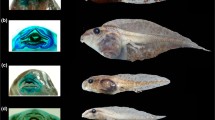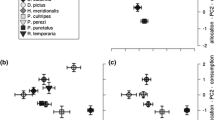Abstract
Tadpoles are important components of food webs at aquatic ecosystems; however, their trophic roles remain understudied compared to fish. Morphology indicates general aspects of tadpole diets (e.g., food size), but a fine association between preferred microhabitats and diet composition remained to be tested. We tested whether syntopic tadpoles differed in microhabitat use and in diet composition according to food availability in different microhabitats. We also tested whether types of microhabitats were consistent in food availability or if food availability would vary among streams. Considering volumes of different food groups ingested, the diets of tadpoles could be partly explained by the microhabitats where they were sampled, but not by streams or even species. Considering number of items of each food group, the diet of tadpoles varied according to stream, microhabitat, and species. Volumes of items of each food group differed among microhabitats, but not among streams. All the studied species could be classified as primary consumers based on the dominance of algae (especially Zygnematophyceae and Bacillariophyceae) in their diets. Patterns of food consumption of tadpoles were complex and responded to variables at a very fine spatial scale, suggesting that they may be sensitive even to small alterations in stream dynamics.





Similar content being viewed by others
References
Altig, R. & G. F. Johnston, 1989. Guilds of anuran larvae: relationships among developmental modes, morphologies, and habitats. Herpetological Monographs 3: 81–109.
Altig, R. & R. W. McDiarmid, 1999. Diversity: familial and generic characterizations. In McDiarmid, R. W. & R. Altig (eds), Tadpoles – The Biology of Anuran Larvae. University of Chicago Press, Chicago, IL: 295–337.
Altig, R., R. Matt & C. L. Taylor, 2007. What do tadpoles really eat? Assessing the trophic status of an understudied and imperiled group of consumers in freshwater habitats. Freshwater Biology 52: 386–395.
Arias, M. M., P. M. Peltzer & R. C. Lajmanovich, 2002. Diet of the giant tadpoles Pseudis paradoxa platensis (Anura, Pseudidae) from Argentina. Phyllomedusa 1: 97–100.
Brezonik, P. L. & C. D. Pollman, 1999. Phosphorus chemistry and cycling in Florida Lakes: global issues and local perspectives. In Reddy, K. R., G. A. O’Connor & C. L. Schelske (eds), Phosphorus Biogeochemistry in Subtropical Ecosystems. Lewis Publishers, Boca Raton, Florida: 69–110.
Cabrera-Guzmán, E., M. R. Crossland & R. Shine, 2013. Mechanisms of competition between tadpoles of Australian frogs (Litoria spp.) and invasive cane toads (Rhinella marina). Freshwater Biology 58: 2584–2600.
Candioti, M. F. V., 2007. Anatomy of anuran tadpoles from lentic water bodies: systematic relevance and correlation with feeding habits. Zootaxa 1600: 1–175.
Collyer, M. L., & D. C. Adams, 2018. RRPP: an r package for fitting linear models to high-dimensional data using residual randomization. Methods in Ecology and Evolution 9: 1772–1779.
Davis, S. D., U. H. Heywood & A. C. Hamilton, 1995. Centres of Plant Diversity: A Guide and Strategy for their Conservation, Volume 3: The Americas. The World Wildlife Fund (WWF) and World Conservation Union (IUCN). IUCN Publications Unit, Cambridge, UK.
Duellman, W. E. & L. Trueb, 1994. Biology of Amphibians. McGraw-Hill, Baltimore.
Dutra, S. L. & M. Callisto, 2005. Macroinvertebrates as tadpole food: importance and body size relationships. Revista Brasileira de Zoologia 22: 923–927.
Gosner, K. L., 1960. A simplified table for staging anuran embryos and larvae with notes on identification. Herpetologica 16: 183–190.
Kloh, J. S., C. C. Figueredo & P. C. Eterovick, 2018. You are what, where, and when you eat: seasonal and ontogenetic changes in a tropical tadpole’s diet. Amphibia-Reptilia 39. https://doi.org/10.1163/15685381-17000209.
Kupferberg, S. J., 1997. The role of larval diet in anuran metamorphosis. American Zoologist 37: 146–159.
Kupferberg, S. J., J. C. Marks & M. E. Power, 1994. Effects of variation in natural algal and detrital diets on a larval anuran (Hyla regilla) life history traits. Copeia 1994: 446–457.
Leite, F. S. F., F. A. Juncá & P. C. Eterovick, 2008. Status do conhecimento, endemismo e conservação de anfíbios anuros da Serra do Espinhaço, Brasil. Megadiversidade 4: 158–176.
Liess, A., J. Guo, M. I. Lind & O. Rowe, 2015. Cool tadpoles from Arctic environments waste fewer nutrients – high gross growth efficiencies lead to low consumer-mediated nutrient recycling in the North. Journal of Animal Ecology 84: 1744–1756.
Lund, R., E. Greenfest-Allen & E. D. Grogan, 2015. Ecomorphology of the Mississippian fishes of the Bear Gulch Limestone (Heath formation, Montana, USA). Environmental Biology of Fishes 98: 739–754.
Mendes, R. S., 2003. Experimentos de enriquecimento in situ: Respostas de algas bentônicas a adição de nutrientes em um córrego de altitude da Serra do Cipó – MG. Masters thesis, Universidade Federal de Minas Gerais, Belo Horizonte, Brazil.
Oksanen J., F. G. Blanchet, M. Friendly, R. Kindt, P. Legendre, D. McGlinn, P. R. Minchin, R. B. O’Hara, G. L. Simpson, P. Solymos, M. H. H. Stevens, E. Szoecs & H. Wagner, 2016. vegan: Community Ecology Package. R package version 2.4-1. https://CRAN.R-project.org/package=vegan.
Osborne, P. L. & A. J. McLachlan, 1985. The effect of tadpoles on algal growth in temporary, rain-filled rock pools. Freshwater Biology 15: 77–87.
Pellegrini, B. G. & C. Ferragut, 2012. Variação sazonal e sucessional da comunidade de algas perifíticas em substrato natural em um reservatório mesotrófico tropical. Acta Botânica Brasileira 26: 810–821.
Pryor, G. S. & K. A. Bjorndal, 2005. Symbiotic fermentation, digesta passage, and gastrointestinal morphology in Bullfrog tadpoles (Rana catesbeiana). Physiological and Biochemical Zoology 78: 201–215.
R Core Team, 2015. R: a language and environment for statistical computing. Version 3.1.0. R Foundation for Statistical Computing, Vienna. http://www.Rproject.org/.
Reynolds, C. S. & P. S. Davies, 2001. Sources and bioavailability of phosphorus fractions in freshwater: a British perspective. Biological Reviews of the Cambridge Philosophical Society 76: 27–64.
Rosenfeld, J. S., 1997. The effect of large macroinvertebrate herbivores on sessile epibenthos in a mountain stream. Hydrobiologia 344: 75–79.
Saadi, A., 1995. A Geomorfologia da Serra do Espinhaço em Minas Gerais e de suas margens. Geonomos 3: 41–63.
Schiesari, L., E. E. Werner & G. W. Kling, 2009. Carnivory and resource-based niche differentiation in anuran larvae: implications for food web and experimental ecology. Freshwater Biology 54: 572–586.
Seale, D. B., 1980. Influence of amphibian larvae on primary production, nutrient flux, and competition in a pond ecosystem. Ecology 61: 1531–1550.
Sousa-Filho, I. F., C. C. Branco, M. P. Telles, G. R. Silva & L. T. Sabagh, 2007. The diet of Scinax angrensis (Lutz) tadpoles in an area of the Atlantic Florest (Mangaratiba, Rio de Janeiro) (Amphibia, Anura, Hylidae). Revista Brasileira de Zoologia 24: 965–970.
Steinwacher, K. & J. Travis, 1983. Influence of food quality and quantity on early larval growth of two anurans. Copeia 1983: 238–242.
Sun, J. & D. Liu, 2003. Geometric models for calculating cell biovolume and surface area for phytoplankton. Journal of Plankton Research 25: 1331–1346.
Tundisi, J. G., T. Matsumura-Tundisi & C. S. Galli, 2006. Eutrofização na América do Sul: causas, consequências e tecnologias para gerenciamento e controle. Associação Instituto Internacional de Ecologia e Geranciamento Ambiental, São Carlos.
Venables, W. N. & B. D. Ripley, 2002. Modern Applied Statistics with S, 4th ed. Springer, New York.
Wassersug, R., 1972. The mechanism of ultraplanktonic entrapment in anuran larvae. Journal of Morphology 137: 279–288.
Wu, C.-S. & Y.-C. Kam, 2005. Thermal tolerance and thermoregulation by Taiwanese rhacophorid tadpoles (Buergeria japonica) living in geothermal hot springs and streams. Herpetologica 61: 35–46.
Zhou, W., M. H. Li, X. Y. Zhang & J. F. He, 2005. Food comparison between tadpoles of Rana catesbeiana and R. chaochiaoensis collected from the same habitat. Zoological Research 26: 89–95.
Zhu, Y. P., H. P. Zhang & J. P. Zhao, 2008. Influence of the South-North water Diversion Project and the mitigation projects on the water quality of Han River. Science of the Total Enviroment 406: 57–68.
Acknowledgements
We are thankful to G. Rodrigues for help during field work, to R. Sawaya and F.S.F. Leite for suggestions in an earlier version of this manuscript, to Dr. Michael Collyer for kindly helping us fit our data and run analyses in RRPP, to the Coordenação de Aperfeiçoamento de Pessoal de Nível Superior (CAPES) for a scholarship provided to J. S. Kloh, and to Conselho Nacional de Desenvolvimento Científico e Tecnológico (CNPq) for a Research Productivity Grant (310162/2017-3) provided to P. C. Eterovick. Collection permits were provided by Sisbio/ICMBio (40270-3).
Author information
Authors and Affiliations
Corresponding author
Additional information
Handling editor: Lee B. Kats
Electronic supplementary material
Below is the link to the electronic supplementary material.
10750_2018_3818_MOESM1_ESM.tif
Supplementary material 1 (TIFF 2741 kb) Figure S1 Relative composition of tadpole diets and available food items at four microhabitats (nVRnC, nVSnC, VRC, VSnC, as described in Fig. 2) in Stream 2 based on (A) volume of food groups and (B) number of items. Bs = Bokermannohyla saxicola, Ba = B. alvarengai, Bn = B. nanuzae, Om = Ololygon machadoi, Pm = Pithecopus megacephalus.
10750_2018_3818_MOESM2_ESM.tif
Supplementary material 2 (TIFF 2928 kb) Figure S2 Relative composition of tadpole diets and available food items at five microhabitats (as described in Fig. 2) in Stream 3 based on (A) volume of food groups and (B) number of items. Bs = Bokermannohyla saxicola, Ba = B. alvarengai, Bn = B. nanuzae, Om = Ololygon machadoi, Pm = Pithecopus megacephalus.
10750_2018_3818_MOESM3_ESM.tif
Supplementary material 3 (TIFF 1507 kb) Figure S3 Relative composition of tadpole diets and available food items at two microhabitats (nVRC, VSC, as described in Fig. 2) in Stream 4 based on (A) volume of food groups and (B) number of items. Bs = Bokermannohyla saxicola, Ba = B. alvarengai, Bn = B. nanuzae, Om = Ololygon machadoi, Pm = Pithecopus megacephalus.
10750_2018_3818_MOESM4_ESM.tif
Supplementary material 4 (TIFF 2700 kb) Figure S4 Relative composition of tadpole diets and available food items at four microhabitats (nVSnC, nVSC, VSnC, VSC, as described in Fig. 2) in Stream 5 based on (A) volume of food groups and (B) number of items. Bs = Bokermannohyla saxicola, Ba = B. alvarengai, Bn = B. nanuzae, Om = Ololygon machadoi, Pm = Pithecopus megacephalus.
10750_2018_3818_MOESM5_ESM.tif
Supplementary material 5 (TIFF 1678 kb) Figure S5 Relative composition of tadpole diets and available food items at two microhabitats (nVRnC, VRC, as described in Fig. 2) in Stream 6 based on (A) volume of food groups and (B) number of items. Bs = Bokermannohyla saxicola, Ba = B. alvarengai, Bn = B. nanuzae, Om = Ololygon machadoi, Pm = Pithecopus megacephalus.
Rights and permissions
About this article
Cite this article
Kloh, J.S., Figueredo, C.C. & Eterovick, P.C. How close is microhabitat and diet association in aquatic ecomorphotypes? A test with tadpoles of syntopic species. Hydrobiologia 828, 271–285 (2019). https://doi.org/10.1007/s10750-018-3818-2
Received:
Revised:
Accepted:
Published:
Issue Date:
DOI: https://doi.org/10.1007/s10750-018-3818-2




